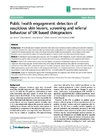| dc.contributor.author | Glithro, Sara | |
| dc.contributor.author | Burrows, Lorna | |
| dc.contributor.author | Hunnisett, Adrian | |
| dc.contributor.author | Cunliffe, Christina | |
| dc.contributor.author | Newell, Dave | |
| dc.date.accessioned | 2018-06-27T16:13:54Z | |
| dc.date.available | 2018-06-27T16:13:54Z | |
| dc.date.issued | 2015 | |
| dc.identifier.citation | Glithro, S., Newell, D., Burrows, L., Hunnisett, A. and Cunliffe, C., 2015. Public health engagement: detection of suspicious skin lesions, screening and referral behaviour of UK based chiropractors. Chiropractic and Manual Therapies, 23:5 https://doi.org/10.1186/s12998-014-0047-2 | en |
| dc.identifier.issn | 2045-709X | |
| dc.identifier.uri | https://aecc.archive.knowledgearc.net/handle/123456789/36 | |
| dc.description | Available under License - Creative Commons Attribution: https://creativecommons.org/licenses/by/4.0/ | en |
| dc.description.abstract | Background:
UK morbidity and mortality rates from skin cancer are increasing despite existing preventative strategies involving education and early detection. Manual therapists are ideally placed to support these goals as they see greater quantities of exposed patient skin more often than most other healthcare professionals. The purpose of this study therefore was to ascertain the ability of manual therapists to detect, screen and refer suspicious skin lesions.
Method:
A web-based questionnaire and quiz was used in a sample of UK chiropractic student clinicians and registered chiropractors to gather data during 2011 concerning skin screening and referral behaviors for suspicious skin lesions.
Results:
A total of 120 questionnaires were included. Eighty one percent of participants agreed that screening for suspicious skin lesions was part of their clinical role, with nearly all (94%) assessing their patients for lesions during examination. Over 90% of the participants reported regularly having the opportunity for skin examination; with nearly all (98%) agreeing they would refer patients with suspicious skin lesions to a medical practitioner. A third of respondents had referred a total of 80 suspicious lesions within the last 12 months with 67% warranting further investigation.
Conclusions:
Nearly all respondents agreed that screening patients for suspicious skin lesions was part of their clinical role, with a significant number already referring patients with lesions. | en |
| dc.language.iso | en | en |
| dc.publisher | Chiropractic and Manual Therapies | en |
| dc.title | Public health engagement: detection of suspicious skin lesions, screening and referral behaviour of UK based chiropractors | en |
| dc.type | Article | en |
| dc.identifier.doi | https://doi.org/10.1186/s12998-014-0047-2 | |
